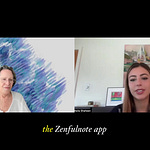Every day, we walk with a part of ourselves we can’t quite see.
It shapes our reactions, feeds our patterns, sabotages our goals, and colors our relationships. It appears in the partner we choose again and again. In the story we tell ourselves when we fail. In the judgment we place on a stranger we barely know.
That part is the shadow. Or, more specifically, the darker mirror of ourselves.
In this live conversation, Dr. Connie Zweig and I explored both the personal and collective nature of the shadow, and why learning to recognize and integrate it is not just a personal journey, but a collective act of healing.
What Is the Shadow?
The shadow is everything about ourselves we’ve disowned, rejected, or suppressed. Usually because someone told us it wasn’t acceptable.
Sometimes that “someone” is society. Sometimes it’s our family. Often, it’s the younger version of us trying to adapt to survive.
“Our shadow holds not only our repressed anger or shame, but also the dream of becoming an artist, our creative gifts, our capacity for vulnerability.” —Dr. Connie Zweig
It can look like addiction. Self-sabotage. Emotional reactivity. Or an obsessive need to perform, perfect, or please. But the shadow doesn’t only hide “negative” traits. It also contains the gold: our unlived potential.
Why Shadow Work Matters
Most of us are walking through life reacting to things we don’t understand. Triggers, judgments, projections, and they all hold clues.
Shadow work gives us a way to decode these reactions, ask deeper questions, and become conscious of what’s driving us.
“It’s a conscious choice to look at the full picture of who you are, and walk hand in hand with it instead of running from it.” —Keila Shaheen
When we begin to look at our shadows—through journaling, dream work, mindfulness, therapy, or mirror dialogue—we begin to reclaim our power. We stop outsourcing blame. We meet the parts of ourselves that feel young, scared, angry, or unwanted. And in doing so, we expand our capacity for intimacy with ourselves and with others.
Signs Your Shadow Is Showing Up
A strong emotional reaction to someone or something
Repeating the same unhelpful pattern (in love, work, habits)
Harsh self-criticism or judgment of others
Avoidance or procrastination around something meaningful
Dreams where you act out in ways your waking self wouldn’t
Becoming aware of your shadow is only the first step. The next is asking:
What is this part of me really needing?
Behind the inner critic may be a need for space. Behind the addict, a need for comfort. Behind the perfectionist, a longing for love that doesn’t depend on performance.
“When we identify the shadow and give it an image, a name, and a voice, we can dialogue with it, and choose a more conscious response.” —Dr. Connie Zweig
Integration doesn’t mean you destroy the shadow. It means you bring it into awareness, meet it with compassion, and respond to its need in a healthier way. This is how wholeness is built. One conversation with yourself at a time.
The Collective Shadow: Why This Work Is BIGGER Than You
One of the most powerful parts of our discussion was when we turned from the personal to the collective.
The same mechanism that creates a personal shadow: repression, denial, and projection, also operates at the level of communities, cultures, and nations.
“If I can’t face what’s uncomfortable in me, I’ll find someone else to carry it for me.” —Dr. Connie
This is how collective shadows form:
Racism
Sexism
Homophobia
Political polarization
Dehumanization of the “other”
Anti-semitism
The collective shadow gets projected onto groups of people, turning them into scapegoats or enemies. And when entire systems are built around these projections, violence becomes normalized. Compassion dies. Projection is weaponized. Division thrives.
Shadow Work Is an Act of Resistance
In a time where fear is politicized, and projection is contagious, doing your own inner work becomes a radical act.
We don’t want to be adding to the darkness. We want to be adding to the light.
That starts by asking:
What stories did I inherit from my family or culture?
What parts of myself do I reject?
What group have I labeled as “the problem”?
Where is my anger hiding, and what is it trying to protect?
Join us.
We’ll be continuing this series here on Substack and in the Zenfulnote app, where we’ll share prompts, exclusive interviews, and deep dives on shadow work in all areas of life.
🎁 Below is a free 3-months of the Zenfulnote app, on us!
IOS: LINK: Here
Android: CODE: Substack3Months (apply code during onboarding)
Lastly, we invite you to join our community group on substack here below for deeper conversations and thoughtful prompts.
🕯 With love and gratitude,
Dr. Connie Zweig and Keila Shaheen
🖤 Thanks for reading Shadow Work to Expand Awareness: a space where inner work meets the outer world through shared prompts, writings, and livestream conversations with Dr. Connie Zweig, Ph.D and Keila Shaheen.
Support our work:
– Get the Zenfulnote App to make inner-work part of your daily life
– Keila’s books: The Shadow Work Journal · The Lucky Girl Journal · The 369 Journal · The Book of Shadow Work · The Light Work Journal NEW! pre-order
– Dr. Connie’s books: Meeting the Shadow · Romancing the Shadow · Meeting the Shadow on the Spiritual Path · The Inner Work of Age– Keila’s website: www.keilashaheen.com
Join the Conversation!
Join our Substack community chat for ongoing discussions, Q&As, and shared insights. + find and save a special image of the prompts above so you can save it and share it with others!










